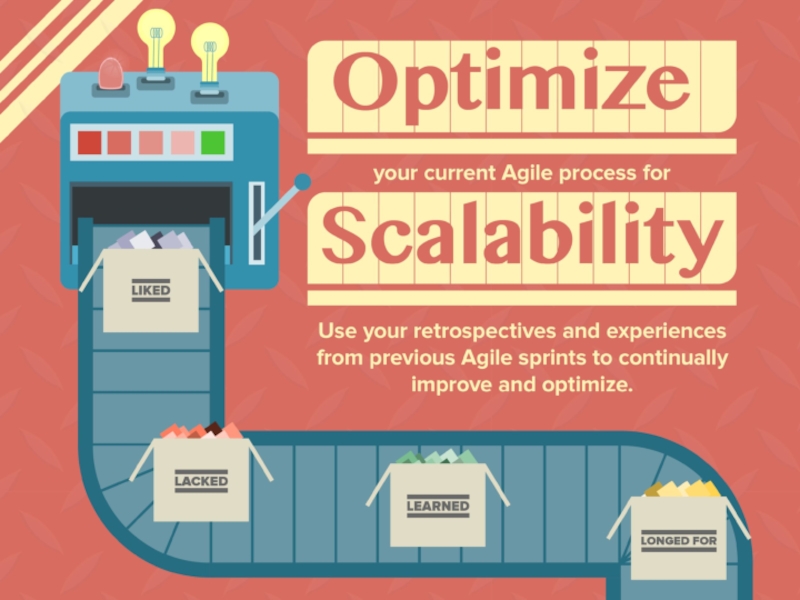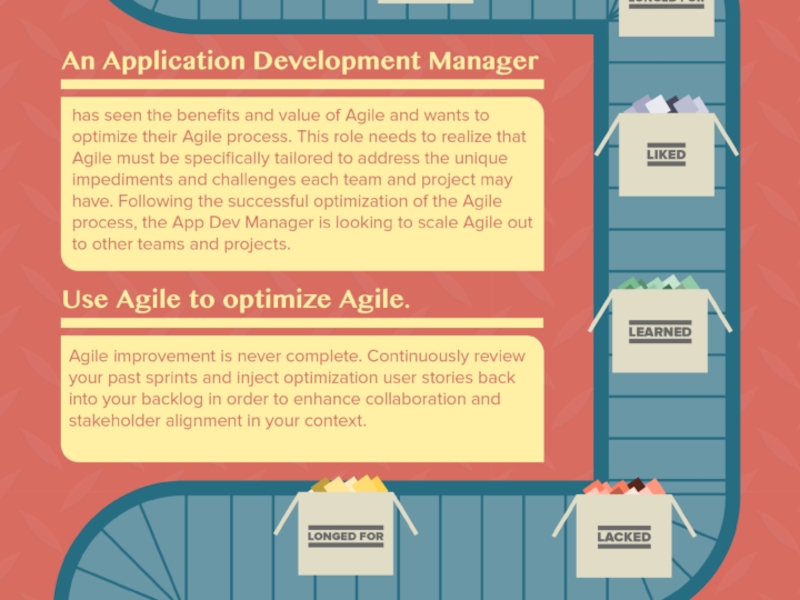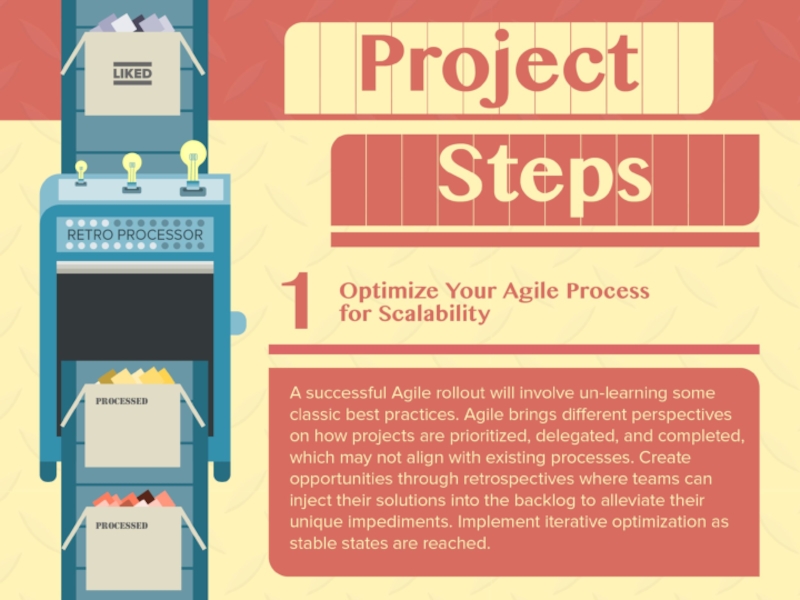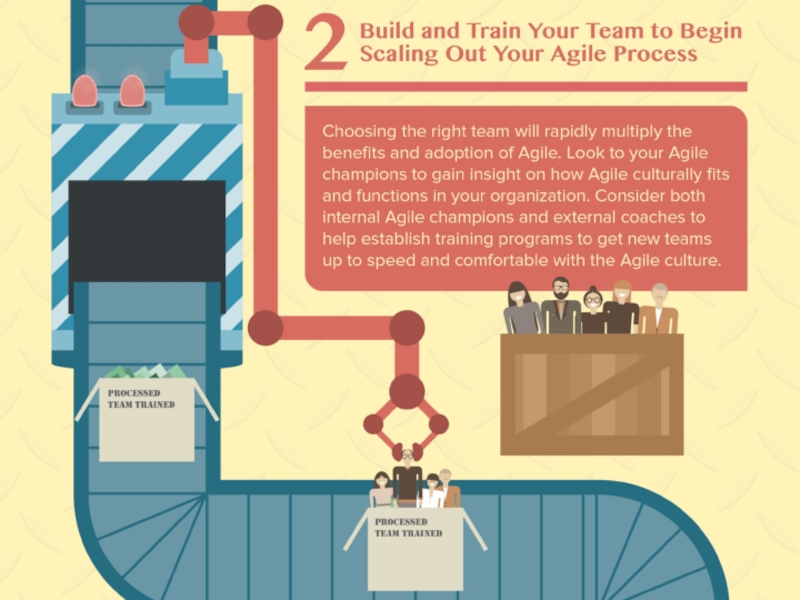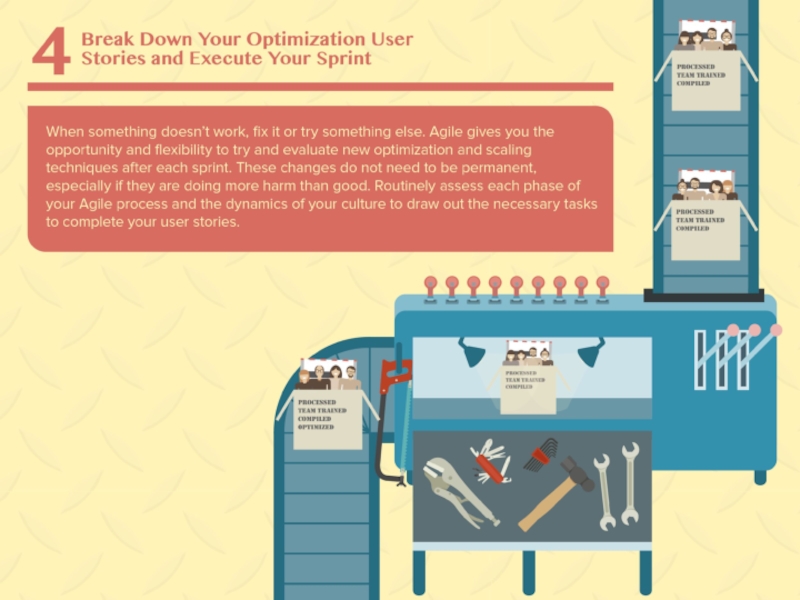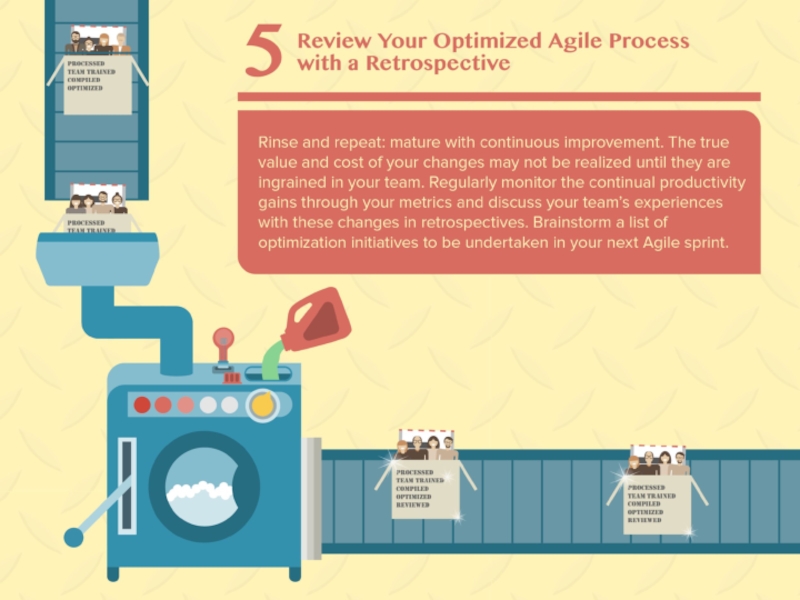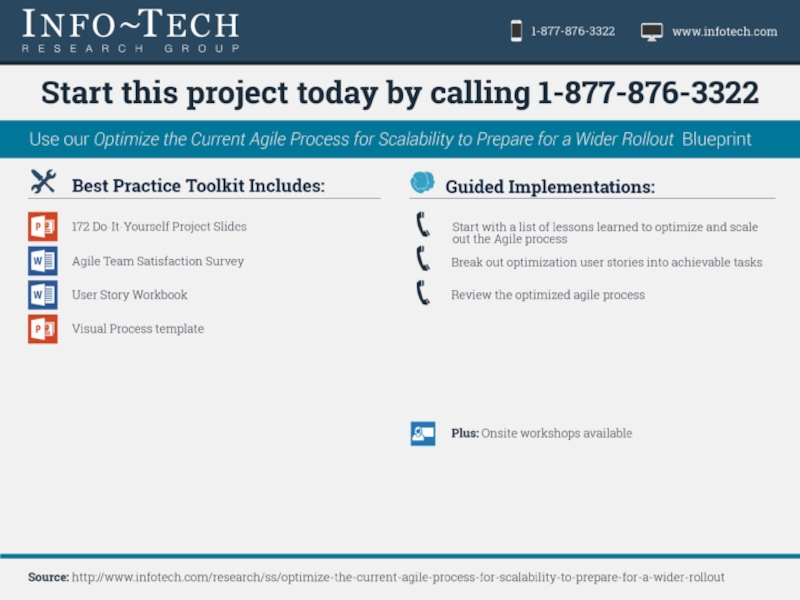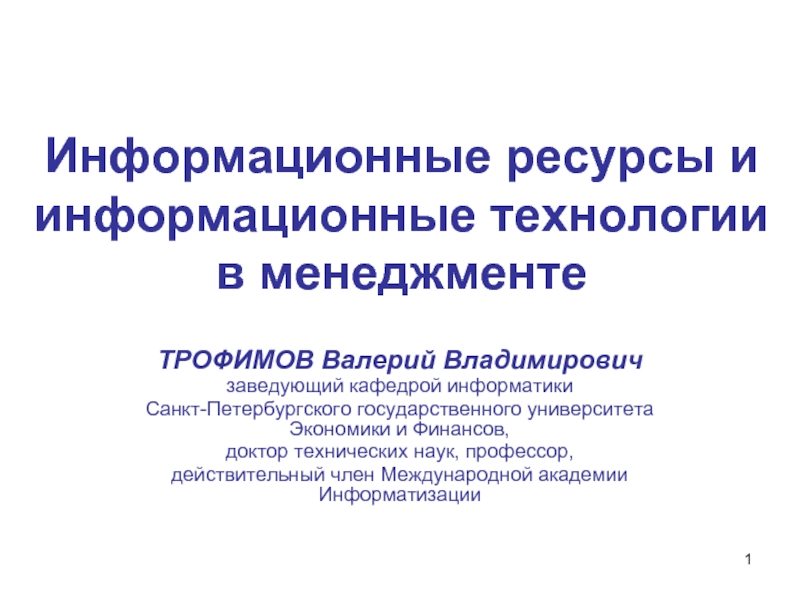Agile Process for Scalability to Prepare for a Wider Rollout
Use your retrospectives and experiences from previous Agile sprints to continually improve and optimize.
Add to Library
Forward
1
Your Challenge
The goal of your initial Agile pilot was to learn how the process functions in your situation and to find and address impediments. As more sprints were completed, your Agile process was refined to better address the working style of the pilot team.
You are now looking to optimize Agile in order to scale it out to multiple teams and projects.
View Storyboard
INFOGRAPHIC
Our Advice
Critical Insight
Your teams may not have the right mindset or flexibility to accept and foster Agile for a wider rollout. It will be harder to manage resistance if teams are not prepared for change and if there is a lack of flexibility in accommodating Agile into your team’s specific context and challenges.
Adding more teams to your projects can present additional collaboration and ownership challenges to an already successful team, since some of the issues were not experienced previously.
Use Agile to implement Agile. Because Agile embraces change, creating a rigid structure to optimize your process is self-defeating. You will never reach an end state with Agile.
Scaling out brings new challenges. There are new perspectives on how multiple projects are prioritized. Cross-team communication and transparency with business stakeholders can take longer and the value of key Agile artifacts can diminish if not managed properly.
Impact and Result
You are constantly looking for ways to optimize the productivity of your teams and increase the communication and collaboration between members in order to complete large projects that are highly relevant and valued to stakeholders.
Conduct Your Retrospective: Discuss your experiences with previous Agile projects with all team members to determine how Agile can be collectively optimized and scaled out to multiple teams.
Optimize and Improve: Identify techniques to optimize your existing Agile implementation before rolling it out to other areas in the organization. Build an Agile culture to improve team cohesion, communication, productivity, and empowerment.
Scale Out: Always keep scalability in mind when rolling out Agile. Communication and process complications can occur as you begin adding more teams of various personalities into one project.
- Главная
- Разное
- Дизайн
- Бизнес и предпринимательство
- Аналитика
- Образование
- Развлечения
- Красота и здоровье
- Финансы
- Государство
- Путешествия
- Спорт
- Недвижимость
- Армия
- Графика
- Культурология
- Еда и кулинария
- Лингвистика
- Английский язык
- Астрономия
- Алгебра
- Биология
- География
- Детские презентации
- Информатика
- История
- Литература
- Маркетинг
- Математика
- Медицина
- Менеджмент
- Музыка
- МХК
- Немецкий язык
- ОБЖ
- Обществознание
- Окружающий мир
- Педагогика
- Русский язык
- Технология
- Физика
- Философия
- Химия
- Шаблоны, картинки для презентаций
- Экология
- Экономика
- Юриспруденция
Applications / Application Selection & Development / Application Development Optimize the Current Agile Process for Scalability to Prepare for a Wider Rollout Use your retrospectives and experiences from previous Agile sprints to continually improv презентация
Содержание
- 1. Applications / Application Selection & Development / Application Development Optimize the Current Agile Process for Scalability to Prepare for a Wider Rollout Use your retrospectives and experiences from previous Agile sprints to continually improv
- 2. Optimize the Agile process for scalability Enhance
Слайд 1 Applications / Application Selection & Development / Application Development
Optimize the Current
Слайд 2Optimize the Agile process for scalability Enhance the Agile process for
a successful scale out within the organization.
Storyboard: Optimize the Current Agile Process for Scalability to Prepare for a Wider Rollout
Build and train the team to begin scaling out the Agile process Create knowledgeable and well-supported Agile project teams within an Agile culture.
Compile a list of lessons learned from previous Agile projects Conduct engaging and insightful retrospectives to uncover impediments experienced in previous Agile projects and sprints.
Agile Team Satisfaction Survey
User Story Workbook
Break down optimization user stories and execute the sprint Create a list of tasks to complete your prioritized optimization user stories and begin your sprint.
Visual Process Template
Review the optimized Agile process with a retrospective Evaluate the fit of your optimization initiatives and identify future optimization opportunities.
Guided Implementation
This guided implementation is a three call advisory process.
Call #1: Start with a list of lessons learned to optimize and scale out the Agile process Conduct Project Retrospectives: Gather all team members around the table and discuss their experiences with past Agile projects. Review the list of successes and pain points to begin building optimization user stories for future Agile sprints.
Call #2: Break out the optimization user stories into achievable tasks Create the Tasks for Your Optimization User Stories: Learn about the solutions to the common Agile issues many organizations are encountering when scaling it out to multiple teams to help build out the tasks to your user stories. Take note of the sentiments that can arise during your Agile sprint.
Call #3: Review the optimized Agile process Review Your Metrics and Agile Process: Discuss your team’s experiences with the changes to your Agile process through a retrospective. Begin building a list of lessons learned to be injected back into your team’s backlogs.
Schedule Your First Call
Onsite Workshop
Module 1: Optimize the Agile Process for Scalability
The Purpose
Stay focused on stakeholder expectations
Anticipate common Agile pitfalls
Stay focused on your culture to ease new teams into Agile
Keep scalability in mind when arranging your teams
Key Benefits Achieved
An understanding of the common Agile challenges
A case to begin optimizing and scaling out Agile to multiple teams
Activities: Outputs:
1.1 Measure your reliency against further Agile adoption High level assessment of your organization’s ability to scale
Module 2: Build and Train the Team to Begin Scaling Out the Agile Process
The Purpose
Conduct both technical and soft skills training with the entire team
Leverage an Agile coach in your training sessions and Agile sprints
Overcome challenges when fostering an Agile culture
Realize the shift in roles when you scale out Agile
Key Benefits Achieved
An understanding of the importance of an Agile coach and enhancing an Agile culture
A clear description of the roles and responsibilities of your Agile teams with scalability in mind
Activities: Outputs:
2.1 Establish the roles and responsibilities of your optimized and scaled-out Agile teams Table of roles and responsibilities
Module 3: Compile a List of Lessons Learned From Previous Agile Projects
The Purpose
Conduct retrospectives to reveal your team’s past experiences with Agile
Benchmark your Agile practices against the principles and values in the Agile manifesto
Assess your metrics to validate your team’s pain points and uncover additional issues
Write your Agile optimization user stories that addresses your team’s needs
Key Benefits Achieved
A list of pain points experienced by your team in past projects and sprints
An evaluation of metrics of past projects
Sized and prioritized Agile optimization user stories
Activities: Outputs:
3.1 Draw your current Agile process Current Agile process flow diagram
3.2 Assess your alignment to the principles of the Agile manifesto Agile manifesto gap assessment
3.3 Conduct your retrospective List of Agile issues and gaps experienced in previous Agile projects
3.4 Write your optimization user stories Agile process optimization user stories
3.5 Size and prioritize your optimization user stories Sizing and prioritization of your optimization user stories
Module 4: Break Down Optimization User Stories and Execute the Sprint
The Purpose
Reinforce your Agile culture with quick wins
Address the common issues and risks of your Agile process: large and distributed teams, project and sprint planning, retrospectives, and demonstrations
Acquire and configure tools to support your Agile implementation
Break down your user stories into achievable tasks
Plan for various team sentiments during the execution of your sprint
Key Benefits Achieved
Suggested solutions to help resolve the issues you identified in the previous module of this workshop
List of tasks for each of your user stories
Strategies to handle potential issues during your Agile sprints
Activities: Outputs:
4.1 Break down your optimization user stories into achievable tasks List of tasks to complete user stories
4.2 Define plans to deal with resistance to change, objections, and fatigue Objections-Response table
4.3 Draw your optimized Agile process Optimized Agile process flow diagram
Module 5: Review the Optimized Agile Process with a Retrospective
The Purpose
Focus on continuous improvement in order to regularly improve performance
Validate and monitor your optimized Agile process
Reflect on the success or failure of your optimized Agile process
Begin to add more Agile teams, if necessary
Key Benefits Achieved
A list of new issues to address in the next Agile sprint
Next steps to continuously scale out Agile
Activities: Outputs:
5.1 Evaluate your optimization initiatives with retrospectives and metrics
Storyboard: Optimize the Current Agile Process for Scalability to Prepare for a Wider Rollout
Build and train the team to begin scaling out the Agile process Create knowledgeable and well-supported Agile project teams within an Agile culture.
Compile a list of lessons learned from previous Agile projects Conduct engaging and insightful retrospectives to uncover impediments experienced in previous Agile projects and sprints.
Agile Team Satisfaction Survey
User Story Workbook
Break down optimization user stories and execute the sprint Create a list of tasks to complete your prioritized optimization user stories and begin your sprint.
Visual Process Template
Review the optimized Agile process with a retrospective Evaluate the fit of your optimization initiatives and identify future optimization opportunities.
Guided Implementation
This guided implementation is a three call advisory process.
Call #1: Start with a list of lessons learned to optimize and scale out the Agile process Conduct Project Retrospectives: Gather all team members around the table and discuss their experiences with past Agile projects. Review the list of successes and pain points to begin building optimization user stories for future Agile sprints.
Call #2: Break out the optimization user stories into achievable tasks Create the Tasks for Your Optimization User Stories: Learn about the solutions to the common Agile issues many organizations are encountering when scaling it out to multiple teams to help build out the tasks to your user stories. Take note of the sentiments that can arise during your Agile sprint.
Call #3: Review the optimized Agile process Review Your Metrics and Agile Process: Discuss your team’s experiences with the changes to your Agile process through a retrospective. Begin building a list of lessons learned to be injected back into your team’s backlogs.
Schedule Your First Call
Onsite Workshop
Module 1: Optimize the Agile Process for Scalability
The Purpose
Stay focused on stakeholder expectations
Anticipate common Agile pitfalls
Stay focused on your culture to ease new teams into Agile
Keep scalability in mind when arranging your teams
Key Benefits Achieved
An understanding of the common Agile challenges
A case to begin optimizing and scaling out Agile to multiple teams
Activities: Outputs:
1.1 Measure your reliency against further Agile adoption High level assessment of your organization’s ability to scale
Module 2: Build and Train the Team to Begin Scaling Out the Agile Process
The Purpose
Conduct both technical and soft skills training with the entire team
Leverage an Agile coach in your training sessions and Agile sprints
Overcome challenges when fostering an Agile culture
Realize the shift in roles when you scale out Agile
Key Benefits Achieved
An understanding of the importance of an Agile coach and enhancing an Agile culture
A clear description of the roles and responsibilities of your Agile teams with scalability in mind
Activities: Outputs:
2.1 Establish the roles and responsibilities of your optimized and scaled-out Agile teams Table of roles and responsibilities
Module 3: Compile a List of Lessons Learned From Previous Agile Projects
The Purpose
Conduct retrospectives to reveal your team’s past experiences with Agile
Benchmark your Agile practices against the principles and values in the Agile manifesto
Assess your metrics to validate your team’s pain points and uncover additional issues
Write your Agile optimization user stories that addresses your team’s needs
Key Benefits Achieved
A list of pain points experienced by your team in past projects and sprints
An evaluation of metrics of past projects
Sized and prioritized Agile optimization user stories
Activities: Outputs:
3.1 Draw your current Agile process Current Agile process flow diagram
3.2 Assess your alignment to the principles of the Agile manifesto Agile manifesto gap assessment
3.3 Conduct your retrospective List of Agile issues and gaps experienced in previous Agile projects
3.4 Write your optimization user stories Agile process optimization user stories
3.5 Size and prioritize your optimization user stories Sizing and prioritization of your optimization user stories
Module 4: Break Down Optimization User Stories and Execute the Sprint
The Purpose
Reinforce your Agile culture with quick wins
Address the common issues and risks of your Agile process: large and distributed teams, project and sprint planning, retrospectives, and demonstrations
Acquire and configure tools to support your Agile implementation
Break down your user stories into achievable tasks
Plan for various team sentiments during the execution of your sprint
Key Benefits Achieved
Suggested solutions to help resolve the issues you identified in the previous module of this workshop
List of tasks for each of your user stories
Strategies to handle potential issues during your Agile sprints
Activities: Outputs:
4.1 Break down your optimization user stories into achievable tasks List of tasks to complete user stories
4.2 Define plans to deal with resistance to change, objections, and fatigue Objections-Response table
4.3 Draw your optimized Agile process Optimized Agile process flow diagram
Module 5: Review the Optimized Agile Process with a Retrospective
The Purpose
Focus on continuous improvement in order to regularly improve performance
Validate and monitor your optimized Agile process
Reflect on the success or failure of your optimized Agile process
Begin to add more Agile teams, if necessary
Key Benefits Achieved
A list of new issues to address in the next Agile sprint
Next steps to continuously scale out Agile
Activities: Outputs:
5.1 Evaluate your optimization initiatives with retrospectives and metrics
